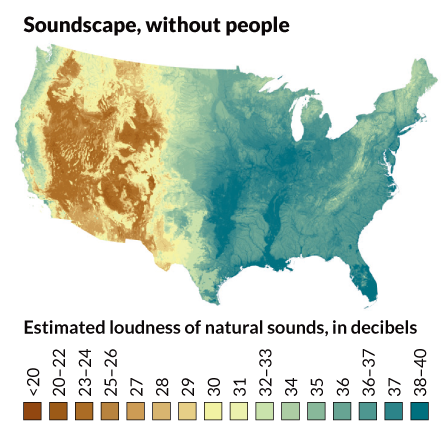The following ScienceNews.org article, titled “A coast-to-coast picture of America’s cacophony of sounds,” was written by Susan Milius and posted on February 16, 2015:
An ambitious National Park Service project exploits computer algorithms to predict the loudness of a typical summer day from coast to coast. The project’s newest map (with yellow representing the loudest noise) includes natural sounds, but it’s the human-made features that jump out.
The eastern half of the United States is louder than the West, according to the map released February 16 at the annual meeting of the American Association for the Advancement of Science in San Jose, Calif. The map shows an average volume, the sound level that’s exceeded about half the time at particular spots. (Typical conversation registers at roughly 50 to 60 decibels.) Airplanes arcing high over the continent don’t show up well, but cities and loud highways are clearly visible.
Researchers also predicted the loudness of a summer’s day in an alternate universe without people. Again, the East is louder overall (green). Much of what drives this difference is water. Rivers rush and brooks babble, of course. But at least as significant to the noisescape are plants rustling in the wind and animals communicating and traipsing through ecosystems that are fueled by water. A corridor along the mighty Mississippi River stands out, as does verdant South Florida. As map coauthor Daniel Mennitt says, “Sound is life, right?”
Complete national sound monitoring is impossible, at least on the Park Service’s budget. So researchers including Kurt Fristrup of the Park Service and Mennitt, of Colorado State University in Fort Collins, fed what data they could find, totaling about 1.5 million hours of acoustical monitoring, into a machine-learning computer program. For each location, the scientists included details such as average summer precipitation and weekly plane overflights. The program discerned patterns in all this geography and predicted where the noise is.
The findings should help urban planners, biologists, and especially the Park Service, whose mission includes the arduous task of preserving some “natural quiet.” Citation: K. W. Fristrup. Predicting sound and light levels at large spatial scales. Presented at the annual meeting of the American Association for the Advancement of Science. February 16, 2015. San Diego.



